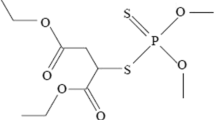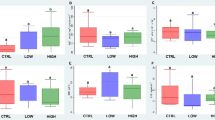Abstract
Environmental monitoring for the effects of organochlorine contaminants has identified changes in egg yolk retinoid concentrations, however underlying mechanisms are unknown. Breeding female Japanese quail, Coturnix coturnix japonica, received 3 bimonthly injections of a low dose (5 µg/g) of the coplanar polychlorinated biphenyl (PCB) 3,3′,4,4′-tetrachlorobiphenyl. No overt maternal toxicity or embryotoxicity was detected. For the exposed females, oocytes (yolk deposition nearly completed) and freshly laid eggs contained higher concentrations of retinol. For PCB-exposed female quail, freshly laid eggs and fertile eggs incubated for 6 days contained higher concentrations of retinyl palmitate. These results suggest that the PCB congener caused greater deposition of retinoids in yolks during late oogenesis or greater net esterification in the yolk-sac membrane. Retinyl ester hydrolase (REH) activity, assayed in the microsomal fraction of the yolk-sac membrane, was significantly inhibited in the PCB-exposed group. Therefore, the higher retinyl palmitate concentrations may be explained by less retinyl palmitate conversion to retinol. In a second experiment, fertile quail eggs were injected with 2, 10 or 20 µg of the PCB congener and incubated for 6 days. In contrast to the maternal exposure, yolk retinol decreased and retinyl ester hydrolase increased in the PCB-injected eggs. The difference in the results of adult versus egg injections may be related to several factors including adult transformation of the PCB to toxic metabolites and differences in post-transcriptional regulation of REH expression.
Similar content being viewed by others
References
Azaïs-Braesco, V., Dodeman, I., Alexandre-Gouabau, M.-C., Partier, A., Borel, P. and Grolier, P. (1995). Vitamin A contained in the lipid droplets of rat liver stellate cells is substrate for acid retinyl ester hydrolase. Biochim. Biophys. Acta 1259, 271-6.
Blaner, W.S. and Olson, J.A. (1994). Retinol and retinoic acid metabolism. In A.B. Sporn and D.S. Goodman (eds) The Retinoids: Biology, Chemistry and Medicine, pp. 229-55. New York: Raven Press.
Boily, M. (2000). Effets des BPC sur les rétinoïdes de l'œuf et sur les activités d'hydrolysation et d'estérification du sac vitellin chez la Caille Japonaise (Coturnix coturnix japonica). p. 140, Université du Québec à Montréal.
Boily, M.H., Champoux, L., Bourbonnais, D.H., DesGranges, J.L., Rodrigue, J.L. and Spear, P.A. (1994). β-Carotene and retinoids in eggs of great blue herons (Ardea herodias) in relation to St. Lawrence River contamination. Ecotoxicology 3, 271-86.
Brunström, B. and Darnerud, P.O. (1983). Toxicity and distribution in chick embryos of 3,3′,4,4′-tetrachlorobiphenyl injected into the eggs. Toxicology 27, 103-110.
Burley, R.W. and Vadehra, D.V. (1989). The Avian Egg: Chemistry and Biology, p. 472, New York: John Wiley.
Carter, J.W. and Mercer, L.P. (1983). Prediction of food intake, weight gain and organ weights in rats as a formulation of dietary Aroclor 1254 (PCBs) by the saturation kinetics model for physiological responses. Nutr. Rep. Int. 27, 561-8.
Champoux, L., DesGranges, J.-L., Rodrigue, J., Hontela, A., Trudeau, S. and Spear, P.A. (2000). Évaluation d'indicateurs biochimiques chez le Grand Héron, Ardea herodias, et le Bihoreau gris, Nycticorax nycticorax, en relation avec la contamination du Saint-Laurent. Série de rapports techniques No. 354, Région du Québec 2000 Service canadien de la faune.
Champoux, L., DesGranges, J-L., Rodrigue, J., Trudeau, S., Boily, M., Hontela, A. and Spear, P.A. (1995). St. Lawrence River ecosystem monitoring: the great blue heron and black-crowned night heron colony of Dickerson Island, Lake St. Francis, Québec. In R.N. Needham and E.N. Novakowski (eds) Sharing the Knowledge, Linking Sciences: an International Conference on the St. Lawrence Ecosystem, pp. 195-210. Proc. Conf. held May 10–12 at Cornwall, Ontario, Canada.
Dersch, H. and Zile, M.H. (1993). Induction of normal cardiovascular development in the vitamin A-deprived quail embryo by natural retinoids. Dev. Biol. 160, 424-33.
Elliott, J.E., Kennedy, S.W. and Lorenzen, A. (1997). Comparative toxicity of polychlorinated biphenyls to Japanese quail (Coturnix c. japonica) and American Kestrels (Falco Sparverius). J. Toxicol. Environ. Health 51, 57-75.
Gilman, A.P., Fox, G.A., Peakall, D.B., Teeple, S.M., Carroll, T.R. and Haymes, G.T. (1977). Reproductive parameters and contaminant levels of Great Lakes herring gulls. J. Wildl. Manag 41, 458-68.
Gregus, Z., Watkins, J.B., Thompson, T.N., Harvey, M.J., Rozman, K. and Klaassen, C.D. (1983). Hepatic phase I and phase II biotransformations in quail and trout: comparison to other species commonly used in toxicity testing. Toxicol. Appl. Pharmacol. 67, 430-41.
Hanberg, A. (1996). 2,3,7,8-Tetrachlorodibenzo-p-dioxin affects retinol esterification in rat hepatic stellate cells and kidney. In Effects of 2,3,7,8 Tetrachlorodibenzo-p-dioxin on Vitamin A Storage in Rat Hepatic Stellate Cells. Stockholm, Sweden: Institute of Environmental medicine.
Harrison, E.H., Gad, M.Z. and Ross, C. (1995). Hepatic uptake and metabolism of chylomicron retinyl esters: probable role of plasma membrane/endosomal retinyl ester hydrolases. J. Lip. Res 36, 1498-506.
Hill, F.W., Scott, M.L., Norris, L.C. and Heuser, G.F. (1961). Reinvestigation of the vitamin A requirement of laying and breeding hens and their progeny. Poult. Sci. 40, 1245-54.
Hofmann, C., Eichele, G. (1994). Retinoids in development In Sporn et al. (eds) The Retinoids: Biology, Chemistry and Medicine, pp. 387-441, New York: Raven Press.
Jensen, R.K., Mathur, S.N., Murthy, S.K. and Ganguly, J. (1987). Vitamin A metabolism in rats chronically treated with 3,3′,4,4′-hexabromobiphenyl Biochem. Biophys. Acta 929, 310-20.
Joshi, P.S., Mathur, S.N., Murthy, S.K. and Ganguly, J. (1973). Vitamin A economy of the developing chick embryo and the freshly hatched chick Biochem. J 136, 757-61.
Lillie, R.J., Cecil, H.C., Bitman, J. and Fries, G.F. (1974). Differences in response of caged white leghorn layers to various polychlorinated biphenyls (PCBs) in the diet Poult. Sci 53, 726-30.
Lorr, N.A. and Bloom, S.E. (1987). Ontogeny of the chicken cytochrome P-450 enzyme system Biochem. Pharmacol 36, 3059-67.
Mercier, M., Pascal, G. and Azaïs-Braesco, V. (1990). Retinyl ester hydrolase and vitamin A status in rats treated with 3,3′,4,4′-tetrachlorobiphenyl Biochem. Biophys. Acta 1047, 70-6.
Mineau, P., Fox, G.A., Norstrom, R.J., Weseloh, D.V., Hallett, D.J. and Ellenton, J.A. (1984). Using the herring gull to monitor levels and effects of organochlorine contamination in the Canadian Great Lakes In J.O. Nriagu and M.S. Simmons (eds) Toxic Contaminants in the Great Lakes, p. 437, New York: John Wiley and Sons.
Murk, A.J., Boudewijn, T.J., Meininger, P.L., Bosveld, A.T.C., Rossaert, G., Ysebaert, T., Meire, P. and Dirksen, S. (1996). Effects of polyhalogenated aromatic hydrocarbons and related contaminants on common tern reproduction: integration of biological, biochemical, and chemical data Arch. Environ. Contam. Toxicol. 31, 128-40.
Murk, A.J., Bosveld, A.T.C., van den Berg, M. and Brouwer, M. (1994a). Effects of polyhalogenated aromatic hydrocarbons (PHAHs) on biochemical parameters in chicks of the common tern (Sterna hirundo). Aquat. Toxicol 30, 91-115.
Murk, A.J., Morse, D., Boon, J. and Brouwer, A. (1994b). In vitro metabolism of 3,3′,4,4′-tetrachlorobiphenyl in relation to ethoxyresorufin-o-deethylase activity in liver microsomes of some wildlife species and rat. Eur. J. Pharmacol 270, 253-61.
Naber, E.C. and Squires, M.W. (1993). Modifying vitamin composition of eggs: a review. J. Appl. Poult. Res. 2, 385-93.
Ndayibagira, A. and Spear, P.A. (1999). Esterification and hydrolysis of vitamin A in liver of brook trout (Salvelinus fontinalis) and the influence of a coplanar polychlorinated biphenyl Comp. Biochem. Phys. Part C 122, 317-25.
Ndayibagira, A., Cloutier, M.-J., Anderson, P.D. and Spear, P.A. (1995). Effects of 3,3′,4,4′-tetrachlorobiphenyl on the dynamics of vitamin A in brook trout (Salvelinus fontinalis) and intestinal retinoid concentrations in lake sturgeon (Acipenser fulvescens) Can. J. Fish. Aquat. Sci 52, 512-20.
Nilsson, C.B., Hanberg, A., Trossvik, C. and Håkansson, H. (1996). 2,3,7,8,-Tetrachlorodibenzo-p-dioxin affects retinol esterification in rat hepatic stellate cells and kidney Environ. Toxicol. Pharmacol 2, 17-23.
Nilsson, C.B., Hoegberg, P., Trossvik, C., Azaïs-Braesco, V., Blaner, W.S., Fex, G., Harrison, E.H., Nau, H., Schmidt, C.K., van Bennekum, A.M. and Håkansson, H. (2000). 2,3,7,8-Tetrachlorodibenzo-p-dioxin increases serum and kidney retinoic acid levels and kidney retinol esterification in the rat Toxicol. Appl. Pharmacol 169, 121-31.
Pan, H.P. and Fouts, J.R. (1978). Drug metabolism in birds Drug. Metab. Rev 7, 1-253.
Peakall, D.B. (1992). Animal Biomarkers as Pollution Indicators London: Chapman & Hall.
Peakall, D.B. (1994). Biomarkers in egg samples. In C.M. Fossi and C. Leonzio (eds) Nondestructive Biomarkers in Vertebrates, pp. 201-16. Boca Raton: Lewis.
Peakall, D.B., Fox, G.A., Gilman, A.P., Hallett, D.J. and Norstrom, R.J. (1978). The herring gull as a monitor of Great Lakes contamination. In B.K. Afghan and D. Mackay (eds) Hydrocarbons and Halogenated Hydrocarbons in the Aquatic Environment, pp. 337-44. New York: Plenum Press.
Peakall, D.B., Peakall, M.L. (1973). Effect of a polychlorinated biphenyl on the reproduction of artificially and naturally incubated dove eggs J. Appl. Ecol. 10, 863-8.
Plack, P.A., Miller, W.S. and Ward, C.M. (1966). Retinal in the blood and liver of the fowl in relation to sex and maturity Biochem. J. 99, 71-5.
Powers, R.H., Gilbert, L.C. and Aust, S.D. (1987). The effect of 3,4,3′,4′-tetrachlorobiphenyl on plasma retinol and hepatic retinyl palmitate hydrolase activity in female Sprague-Dawley rats Toxicol. Appl. Pharmacol 89, 370-7.
Rolland, R.M. (2000). A review of chemically-induced alterations in thyroid and vitamin A status from field studies of wildlife and fish J. Wildl. Dis. 36, 615-35.
Spear, P.A. and Bourbonnais, D.H. (2000). Use of retinoids as biomarkers In L. Lagadic, T. Caquet and J.-C. Amiard, F. Ramade (eds) Use of Biomarkers for Environmental Quality Assessment, p. 350. Enfield: Science Publishers.
Spear, P.A., Bourbonnais, D.H., Norstrom, R.J., Moon, T.W. (1990). Yolk retinoids (vitamin A) in eggs of the herring gull and correlations with polychlorinated dibenzo-p-dioxins and dibenzofurans. Environ. Toxicol. Chem 9, 1053-61.
Spear, P.A., Bourbonnais, D.H., Peakall, D.B. and Moon, T.W. (1989). Dove reproduction and retinoid (vitamin A) dynamics in adult females and their eggs following exposure to 3,3′,4,4′-tetrachlorobiphenyl. Can. J. Zool. 67, 908-13.
Spear, P.A., Moon, T.W. and Peakall, D.B. (1986). Liver retinoid concentrations in natural populations of herring gulls (Larus argentatus) contaminated by 2,3,7,8-tetrachlorodibenzo-p-dioxin and in ring doves (Streptopelia risoria) injected with a dioxin analogue. Can. J. Zool. 64, 204-8.
Spencer, F. (1982). An assessment of the reproductive toxic potential of Aroclor 1254 in female Sprague-Dawley rats Bull. Environ. Contam. Toxicol. 28, 290-7.
Squires, M.W., Naber, E.C. (1993). Vitamin profiles of eggs as indicators of nutritional status in the laying hen: vitamin A study Poult. Sci. 72, 154-64.
Thaller, C., Eichele, G. (1988). Characterization of retinoid metabolism in the developing chick limb bud. Development 103, 473-83.
Tumasonis, C.B., Bush, B., Baker, F.D. (1973). PCB levels in egg yolks associated with embryonic mortality and deformity of hatched chicks Arch. Environ. Contam. Toxicol. 4, 312-24.
Wehler, E.K., Brunström, B., Rannug, U., Bergman, Å. (1990). 3,3′,4,4′-tetrachlorobiphenyl: metabolism by the chick embryo in ovo and toxicity of hydroxylated metabolites Chem.-Biol. Interactions 73, 121-32.
Zile, M.H., Kostetskii, I., Yaun, S. (1998). Vitamin A specifies heart asymmetry during avian cardiogenesis J. Fed. Amer. Soc. Exp. Biol. 12, 319.
Zile, M.H., Summer, C., Aulerich, R., Bursian, S.J., Tillitt, D.E., Giesy, J.P., Kubiak, T.J. (1997). Retinoids in eggs and embryos of birds fed fish from the Great Lakes Environ. Toxicol. Pharmacol. 3, 277-88.
Author information
Authors and Affiliations
Corresponding author
Rights and permissions
About this article
Cite this article
Boily, M.H., Ndayibagira, A. & Spear, P.A. Retinoids, LRAT and REH Activities in Eggs of Japanese Quail Following Maternal and in ovo Exposures to 3,3′,4,4′-Tetrachlorobiphenyl. Ecotoxicology 12, 9–21 (2003). https://doi.org/10.1023/A:1022572425466
Issue Date:
DOI: https://doi.org/10.1023/A:1022572425466




